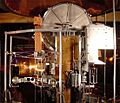Kilogram facts for kids
Quick facts for kids kilogram |
|
|---|---|
|
The NIST-4 Kibble balance
|
|
| General information | |
| Unit system | SI base unit |
| Unit of | Mass |
| Symbol | kg |
| Conversions | |
| 1 kg in ... | ... is equal to ... |
| Natural units | 5.609×1029 MeV/c2 |
| Imperial units | 2.20462262 lbs |
The kilogram (symbol: kg) is the main unit for measuring mass in the International System of Units (SI). You might also hear it called a kilo.
It was first defined as the mass of one litre of water. But this was hard to measure exactly. So, scientists later used a special metal object to define it. This object was the standard for many years.
However, this metal object slowly changed over time. This meant the definition of the kilogram was not perfectly stable. Because of this, scientists worked to find a new, more precise way to define the kilogram.
Since May 20, 2019, the kilogram has been defined using a fundamental constant of nature called the Planck constant. This makes the kilogram's definition much more stable and accurate.
Contents
What is a Kilogram?
The kilogram is a way to measure how much "stuff" is in an object. This is called its mass. If something has a mass of one kilogram, it means it has the same amount of "stuff" as the official kilogram standard.
To give you an idea, one kilogram is a little more than 2.2 pounds. A large bottle of soda or a bag of sugar often weighs about one kilogram.
A tonne is a much larger unit of mass. One tonne is equal to one thousand kilograms. Also, one litre of water weighs almost exactly one kilogram. This was the original idea for defining the kilogram.
How the Kilogram Was Defined Before
For a long time, the kilogram was defined by a specific piece of metal. This metal object was called the International Prototype Kilogram (IPK). It was made in 1879 and officially chosen as the kilogram standard in 1889.
The IPK was made from a special mix of 90% platinum and 10% iridium. These metals were chosen because they do not rust or wear away easily. The IPK is kept safe in a special vault at the BIPM in Sèvres, France.
Before the IPK, from 1795 to 1799, the unit of mass was called the "grave".
Over time, even the IPK could collect dust. To make sure measurements were accurate, it had to be carefully cleaned before being used. Scientists noticed that the IPK and its copies were slowly changing their mass by a tiny amount. This small change, about 50 micrograms, was a problem for very precise science.
The New Definition of the Kilogram
Because the old metal standard was not perfect, scientists looked for a better way to define the kilogram. They wanted a definition based on something that never changes.
They found this in the Planck constant. This constant is a basic number in physics that relates a particle's energy (and therefore its mass) to its frequency. It's a fundamental part of how the universe works.
On November 16, 2018, the General Conference on Weights and Measures (CGPM) approved the new definition. This new definition officially came into force on May 20, 2019.
Now, the kilogram is defined using the Planck constant, along with the definitions of the second and the metre. Since the second and metre are also defined by unchanging physical constants, the kilogram is now defined only by these stable constants of nature. This means the kilogram's definition is now much more precise and will never change.
Images for kids
See also
 In Spanish: Kilogramo para niños
In Spanish: Kilogramo para niños




